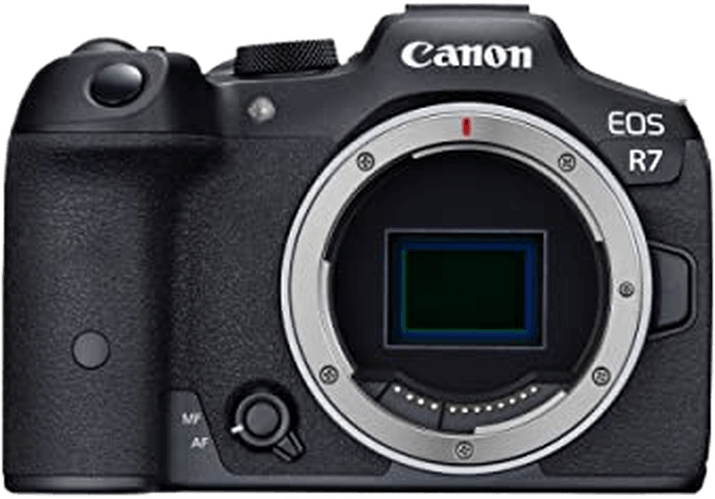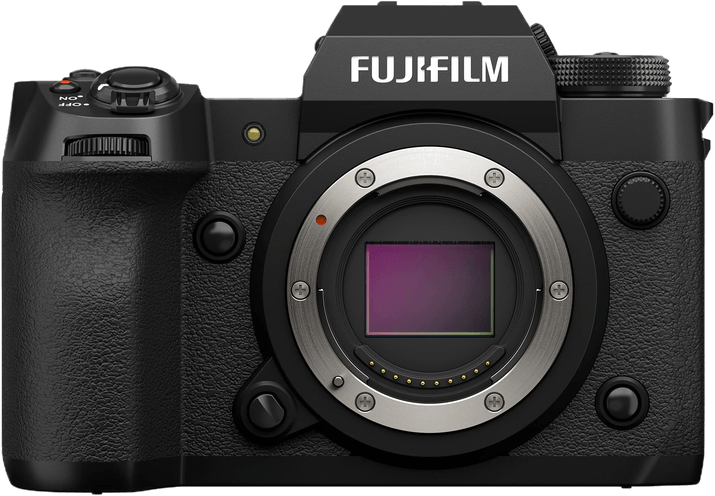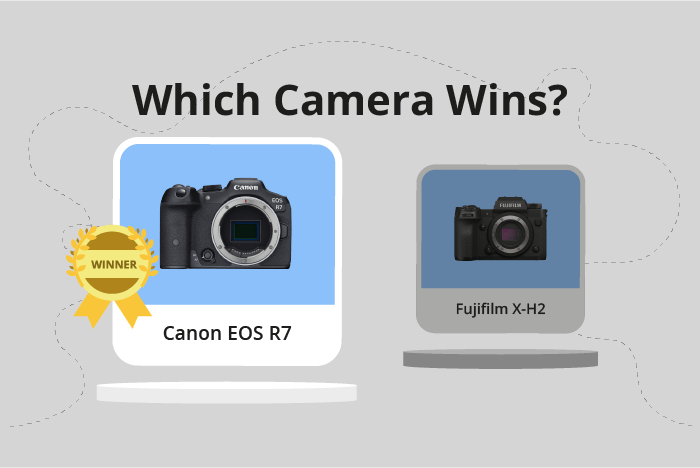Canon EOS R7 vs Fujifilm X-H2 Comparison
Canon EOS R7

Fujifilm X-H2

The Canon EOS R7 edges out the Fujifilm X-H2 with a score of 83/100 compared to 82/100. Both cameras are mirrorless and were announced in May 2022, with similar sizes and weights – the Canon EOS R7 measures 132x90x92mm and weighs 612g, while the Fujifilm X-H2 measures 136x93x95mm and weighs 660g.
The Canon EOS R7 has the advantage of a lower launch price at $1500 compared to the Fujifilm X-H2’s $1999 price tag. Additionally, the EOS R7 is slightly smaller and lighter, making it more convenient for travel and extended use.
On the other hand, the Fujifilm X-H2 still offers excellent performance despite its higher price and marginally larger size. Its one-point lower score does not mean it is significantly inferior to the Canon EOS R7.
Taking these factors into consideration, the Canon EOS R7 is a more budget-friendly and portable option for photographers, while the Fujifilm X-H2 remains a strong contender for those willing to invest in a slightly more expensive and heftier camera.
Canon EOS R7 vs Fujifilm X-H2 Overview and Optics
The Canon EOS R7 takes the lead in optics with a score of 82/100, while the Fujifilm X-H2 follows closely with a score of 81/100. Both cameras share several common specifications, including a shooting speed of 15 frames per second, a CMOS sensor type, APS-C sensor size, and image stabilization. Additionally, both cameras have their respective lens mounts: Canon RF for the EOS R7 and Fujifilm X for the X-H2.
The Canon EOS R7 outperforms the Fujifilm X-H2 in certain aspects. It boasts a higher DXOMARK score for the sensor at 97, indicating superior image quality. The R7 also benefits from the Digic X processor, which is known for its fast processing speed and excellent noise reduction capabilities.
On the other hand, the Fujifilm X-H2 holds an advantage in megapixels, with 40 compared to the Canon EOS R7’s 33. This means the X-H2 can capture more detail in images, making it an attractive option for those who prioritize image resolution. However, it is important to note that DXOMARK does not score Fujifilm cameras, so a direct comparison of the sensor quality is not available. The X-H2 also utilizes the X-Processor 5, which is a respectable processor in its own right.
Taking these factors into account, the Canon EOS R7 emerges as the winner in terms of overall optics performance, primarily due to its superior sensor quality and processing capabilities. However, the Fujifilm X-H2 remains a strong contender, especially for those who prioritize higher megapixel counts and the unique Fujifilm X lens mount. Both cameras offer excellent performance, but the Canon EOS R7 holds a slight edge in optics.
Canon EOS R7 vs Fujifilm X-H2 Video Performance
The Canon EOS R7 outperforms the Fujifilm X-H2 in video capabilities, scoring 91/100 compared to the Fujifilm’s 83/100. Both cameras share some common specifications, such as 4K maximum video resolution and 3840 x 2160 maximum video dimensions. Additionally, both cameras have built-in time-lapse functionality, making them suitable for capturing dynamic scenes over extended periods.
The Canon EOS R7 excels with its higher maximum video frame rate of 120fps, compared to the Fujifilm X-H2’s 60fps. This allows the Canon EOS R7 to capture smoother, more detailed slow-motion footage, providing greater creative freedom for videographers. The higher frame rate also contributes to the camera’s superior video score.
On the other hand, the Fujifilm X-H2 still delivers quality video performance. Despite the lower maximum frame rate, the camera’s 4K resolution and time-lapse functionality enable users to capture stunning, high-resolution footage. However, its lower score reflects the limitations in slow-motion capabilities compared to the Canon EOS R7.
In comparing the video capabilities of the Canon EOS R7 and the Fujifilm X-H2, it is evident that the Canon EOS R7 offers more advanced features, particularly in terms of its maximum video frame rate. This makes it a better choice for videographers seeking greater flexibility and creative options. Meanwhile, the Fujifilm X-H2 remains a solid option for those who prioritize 4K resolution and time-lapse functionality, but may not require the advanced slow-motion capabilities offered by the Canon EOS R7.
Canon EOS R7 vs Fujifilm X-H2 Features and Benefits
The Canon EOS R7 and the Fujifilm X-H2 both have a feature score of 85/100, making them equal in this category. They share several specifications, such as a 3-inch screen size, 1,620,000-dot screen resolution, touchscreen capabilities, flip screens, and the absence of GPS. Additionally, both cameras offer Wi-Fi and Bluetooth connectivity.
Despite their equal scores, the Canon EOS R7 does have some advantages over the Fujifilm X-H2. For instance, the EOS R7 is known for its superior autofocus system, which provides faster and more accurate focusing. This advantage helps users capture sharp images, even in challenging lighting conditions. Furthermore, the EOS R7 typically has a longer battery life than the X-H2, allowing photographers to shoot for extended periods without needing to recharge or swap batteries.
On the other hand, the Fujifilm X-H2 also has areas where it surpasses the Canon EOS R7. The X-H2 boasts a more extensive selection of film simulations, which allows users to achieve a variety of unique looks and styles in their images. Additionally, the X-H2 has a more robust build quality, making it a more durable option for photographers who frequently shoot in harsh environments.
Considering these points, both the Canon EOS R7 and the Fujifilm X-H2 have their strengths and weaknesses. The EOS R7 excels in areas such as autofocus and battery life, while the X-H2 stands out with its film simulations and build quality. Ultimately, the choice between these two cameras comes down to personal preference and the specific needs of the photographer.
Canon EOS R7 vs Fujifilm X-H2 Storage and Battery
The Canon EOS R7 and the Fujifilm X-H2 tie in storage and battery with a score of 79/100. Both cameras have two memory card slots, accepting SD/SDHC/SDXC (UHS-II compatible) cards for the Canon EOS R7 and CFexpress Type B and SD (UHS-II compatible) cards for the Fujifilm X-H2. Additionally, both cameras offer USB charging.
The Canon EOS R7 has a battery life of 660 shots and uses an LP-E6NH battery. In contrast, the Fujifilm X-H2 has a slightly longer battery life of 680 shots and uses an NP-W235 battery. The Fujifilm X-H2 is superior in terms of battery life.
On the other hand, the Canon EOS R7 accepts more common memory card types, making it easier for photographers to find compatible cards. This advantage favors the Canon EOS R7.
Both cameras perform well in storage and battery, with the Fujifilm X-H2 having a slightly longer battery life and the Canon EOS R7 accepting more widely available memory cards. Ultimately, the choice depends on the user’s preferences and priorities.
Alternatives to the Canon EOS R7 and Fujifilm X-H2
Are you still undecided about which camera is right for you? Have a look at these popular comparisons that feature the Canon EOS R7 or the Fujifilm X-H2:

